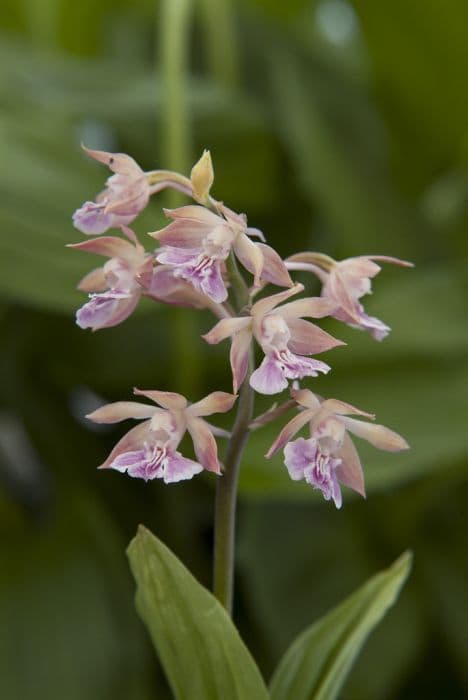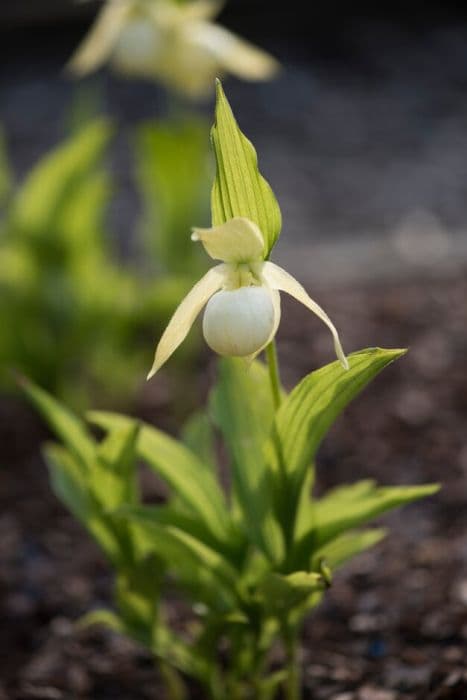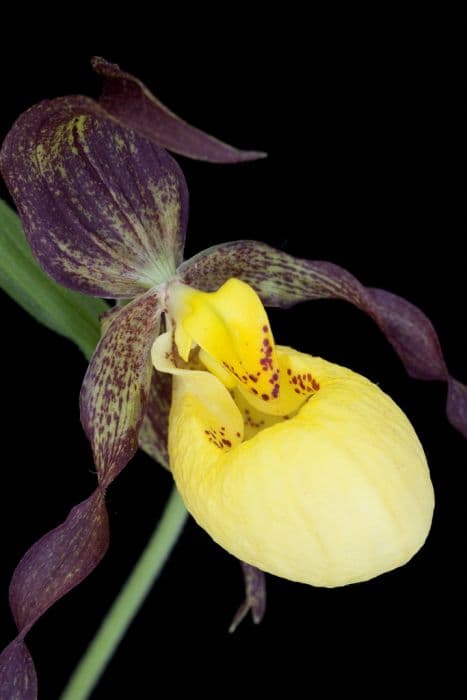Lady's Slipper Orchid Cypripedium Dietrich gx

ABOUT
The Cypripedium Dietrich, commonly known as the Lady's Slipper Orchid, is a captivating perennial plant with visually striking features. It boasts bold and beautiful flowers that are reminiscent of a slipper or pouch, which is the hallmark of this species. The blossoms typically have a rich blend of colors, often showcasing a dominant hue of pink, white, or yellow, complemented by intricate veins and speckles that add depth and character to their appearance. These striking blooms are held aloft by upright stems that are adorned with a spiral arrangement of leaves. The foliage is lance-shaped with a lush green color that creates a striking backdrop for the flowers. The leaves are sometimes pleated, giving them a textured look that enhances the overall aesthetics of the plant. This Lady's Slipper Orchid exudes a delicate charm that has captured the hearts of many plant enthusiasts and makes it a highly coveted addition to gardens and indoor plant collections. Despite its exquisite beauty, the plant has a robust nature and can often be found in the wild in temperate zones, where it graces the landscape with its unique and eye-catching flowers.
About this plant
 Names
NamesSynonyms
Lady's Slipper, Slipper Orchid, Moccasin Flower.
Common names
Cypripedium Dietrich gx.
 Toxicity
ToxicityTo humans
The Cypripedium Dietrich gx is commonly known as a Lady's Slipper orchid. Generally, Lady's Slipper orchids are not considered toxic to humans. However, contact with the skin can sometimes cause dermatitis or skin irritation in sensitive individuals. Ingesting any part of the plant is not advisable as it could potentially cause gastrointestinal discomfort due to the presence of naturally occurring chemicals that are meant to deter herbivores. It is always recommended to exercise caution and avoid eating ornamental plants for safety.
To pets
The common name for Cypripedium Dietrich gx is Lady's Slipper orchid. This plant is generally not known to be toxic to pets. However, if ingested, it might cause mild gastrointestinal upset, including symptoms such as vomiting or diarrhea. As with any non-food plant, it's best to prevent pets from chewing on Lady's Slipper orchids to avoid any potential discomfort or complications. If you suspect your pet has ingested any part of the plant and is showing adverse symptoms, consult with a veterinarian.
 Characteristics
CharacteristicsLife cycle
Perennials
Foliage type
Deciduous
Color of leaves
Green
Flower color
Varies
Height
1-2 feet (0.3-0.6 meters)
Spread
1 feet (0.3 meters)
Plant type
Herb
Hardiness zones
5
Native area
North America
Benefits
 General Benefits
General Benefits- Ornamental Value: Cypripedium, commonly known as Lady’s Slipper Orchid, is prized for its beautiful and unique flowers, which can enhance the visual appeal of gardens and indoor spaces.
- Habitat Support: This plant can contribute to the biodiversity of an area by providing habitat and nutrients for a variety of insects and other wildlife.
- Educational Interest: Horticulturists and botany enthusiasts often use Lady’s Slipper Orchids to study orchid pollination mechanisms and adaptation strategies.
- Cultural Significance: The Lady’s Slipper Orchid holds cultural importance in many regions and is often associated with folklore and tradition, adding intangible value to gardens and wild spaces.
- Conservation: Growing Lady’s Slipper Orchids can support conservation efforts by raising awareness and appreciation for native plant species and their ecosystems.
 Medical Properties
Medical PropertiesThis plant is not used for medical purposes.
 Air-purifying Qualities
Air-purifying QualitiesThis plant is not specifically known for air purifying qualities.
 Other Uses
Other Uses- Lady's Slipper Orchids can be used as a unique subject in photography due to their distinctive and photogenic pouch-shaped blooms.
- As a conservation symbol, they serve to educate the public about the importance of preserving native habitats and species.
- The complex structures make them an interesting subject for botanical studies and illustrations that are used in educational materials.
- In horticulture, they are prized for hybridization experiments to create new varieties with diverse colors and patterns.
- Lady's Slipper Orchids can inspire artists and craftspeople to create jewelry and art pieces that mimic their unique form and beauty.
- They are used in landscape design for shade gardens to provide a natural and attractive ground cover option.
- Their presence in a garden can be a natural attractant for certain species of bees and other pollinators, thus supporting local ecosystems.
- Cultivation of Lady's Slipper Orchids can provide economic benefits to nurseries specializing in rare and exotic plants.
- They are sometimes used in themed gardens or educational botanical gardens that focus on the flora of specific regions.
- As a cultural symbol, some regions may feature the Lady's Slipper Orchid in local festivals or horticultural shows to celebrate native plant life.
Interesting Facts
 Feng Shui
Feng ShuiThe Lady's Slipper orchid is not used in Feng Shui practice.
 Zodiac Sign Compitability
Zodiac Sign CompitabilityThe Lady's Slipper orchid is not used in astrology practice.
 Plant Symbolism
Plant Symbolism- Beauty and Refinement: The Cypripedium, commonly known as the Lady's Slipper Orchid, often symbolizes beauty and refinement, akin to the delicate and striking appearance of its bloom.
- Capriciousness: The rarity and unique form of the Lady's Slipper Orchid can represent capriciousness, suggesting whimsical or unpredictable behavior, reflecting the plant's varied growth patterns.
- Rarity and Value: Due to its uncommon nature and the difficulties in cultivation, the Lady's Slipper Orchid can symbolize something of rarity and high value, much as precious jewels or artifacts are treasured.
- Femininity and Softness: The shape of the orchid's pouch-like labellum is reminiscent of a soft and elegant slipper, often associated with feminine beauty and softness.
 Water
WaterLady Slipper orchids, including the Cypripedium Dietrich gx, require regular watering that keeps their substrate consistently moist but not waterlogged. You should water these orchids once a week with roughly 8-12 ounces of water, depending on the size of the pot and the ambient temperature and humidity. During the active growth period in spring and summer, you may need to water more frequently, especially if the plant is outdoors or in a warm environment. In the winter months, when the plant is not actively growing, reduce watering to every other week. Always use room temperature water and avoid letting it sit directly in water, as stagnant moisture can lead to root rot.
 Light
LightLady Slipper orchids prefer bright, indirect light with protection from the harsh midday sun. A north or east-facing window is ideal for providing the soft light they thrive in. If you're growing Cypripedium Dietrich gx outdoors, a spot with partial shade that mimics the dappled sunlight of their natural woodland habitat is best. Direct sunlight should be avoided as it can scorch the leaves.
 Temperature
TemperatureThe Lady Slipper orchid enjoys moderate temperatures, with ideal conditions ranging from 60 to 75°F during the day and not dropping below 50°F at night. Cypripedium Dietrich gx can handle brief periods of cold down to about 40°F, but frost is harmful and should be avoided. Consistently warm conditions within the ideal range support the health and flowering of the plant.
 Pruning
PruningPruning Lady Slipper orchids typically involves the removal of dead or damaged foliage to maintain plant health and aesthetics. After flowering, prune the flower spike close to the base, and any yellow or brown leaves can be gently removed to stimulate new growth. The best time for pruning Cypripedium Dietrich gx is in the fall, after the plant has entered dormancy.
 Cleaning
CleaningAs needed
 Soil
SoilThe Lady Slipper orchid (Cypripedium Dietrich gx) thrives in a soil mix that is well-aerating and has excellent drainage. A recommended mix includes equal parts of fine pine bark, peat moss, and perlite or pumice, with the addition of some leaf mold if available. Aim for a slightly acidic to neutral soil pH, around 5.5 to 7.
 Repotting
RepottingLady Slipper orchids generally require repotting every one to three years. However, since they dislike disturbance, only repot the Lady Slipper when necessary, such as when the potting medium breaks down or the plant outgrows its container.
 Humidity & Misting
Humidity & MistingLady Slipper orchids prefer moderate to high humidity, with ideal levels being between 40-70%. This mimics their natural understory habitat where they have consistent access to atmospheric moisture.
 Suitable locations
Suitable locationsIndoor
Provide bright, indirect light and maintain high humidity for indoor Lady Slippers.
Outdoor
Shelter Lady Slippers from direct sun and ensure soil is consistently moist.
 Life cycle
Life cycleThe Lady's Slipper Orchid (Cypripedium Dietrich gx) begins its life cycle when a seed germinates, often with the help of a symbiotic fungus, which assists in the absorption of nutrients. The seedling develops into a protocorm, an intermediary stage before true leaves form. Once the protocorm matures, it produces a rosette of leaves, and a rhizome starts to develop, from which new shoots can emerge. Over a period of several years, the plant reaches maturity and can produce its characteristic slipper-shaped flowers, usually in the spring or early summer season. After pollination, which often relies on specific insect species, the orchid will produce seed capsules filled with thousands of minute seeds. Finally, the seeds are dispersed by wind due to their lightweight and small size, repeating the life cycle if they land in a suitable environment.
 Propogation
PropogationPropogation time
Spring to Fall
Propogation: The Cypripedium Dietrich gx, commonly known as Lady's Slipper orchid, is often propagated by division, which is the most popular method due to its simplicity and effectiveness. This technique should ideally be performed in the late summer or early fall, when the plant is entering dormancy. To propagate by division, carefully lift the orchid clump from the soil, making sure to keep as many roots intact as possible. Then, using your hands or a sterile knife, gently divide the clump into smaller segments, each with at least two or three growth points or "eyes." Once divided, these segments can be immediately replanted in a media that is well-draining and suitable for terrestrial orchids. It's crucial to water the new divisions sparingly until new growth is evident, indicating they have established successfully.









